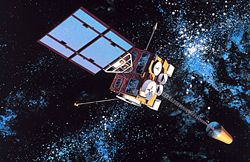 Artistic rendering of GOES-U once deployed | |
| Names | Geostationary Operational Environmental Satellite-U |
|---|---|
| Mission type | Earth weather forecasting |
| Operator | NOAA / NASA |
| COSPAR ID | 2024-119A |
| SATCAT no. | 60133 |
| Mission duration | 15 years (planned) 481 days, 17 hours, 12 minutes (in progress) |
| Spacecraft properties | |
| Bus | A2100 |
| Manufacturer | Lockheed Martin |
| Launch mass | 5,000 kg (11,023 lb) |
| Dry mass | 2,925 kg (6,449 lb) |
| Start of mission | |
| Launch date | 25 June 2024, 21:26 UTC [1] (5:26 pm EDT) |
| Rocket | Falcon Heavy |
| Launch site | Kennedy Space Center, LC-39A |
| Contractor | SpaceX |
| Entered service | 7 April 2025 [2] |
| Orbital parameters | |
| Reference system | Geocentric orbit |
| Regime | Geostationary orbit |
| Longitude | 75.2° west (planned) [3] |
| Semi-major axis | 41,845 km (26,001 mi) [4] |
| Eccentricity | 0.0045031 [4] |
| Perigee altitude | 35,286.4 km (21,926.0 mi) [4] |
| Apogee altitude | 35,663.3 km (22,160.1 mi) [4] |
| Inclination | 0.1204° [1] |
| Period | 24 hours [4] |
| Epoch | July 12, 2024 |
 GOES-U mission insignia | |
GOES-19 (designated GOES-U prior to reaching geostationary orbit) is a weather satellite, the fourth and last of the GOES-R series of satellites operated by the National Oceanic and Atmospheric Administration (NOAA). The GOES-R series will extend the availability of the Geostationary Operational Environmental Satellite (GOES) system until 2036. The satellite is built by Lockheed Martin, based on the A2100 platform. [5] [6] The satellite was placed into service as the GOES-East position and GOES-16 was stored as backup on April 7, 2025. [7]
